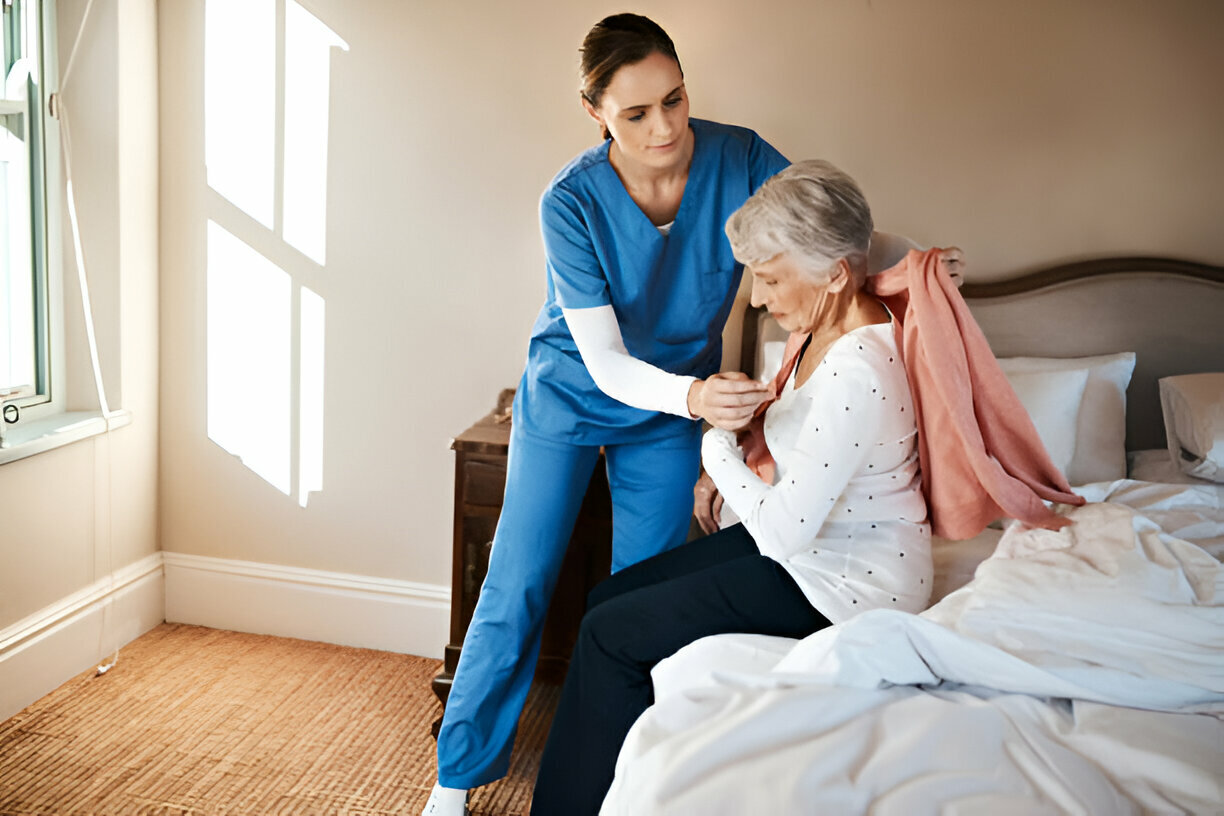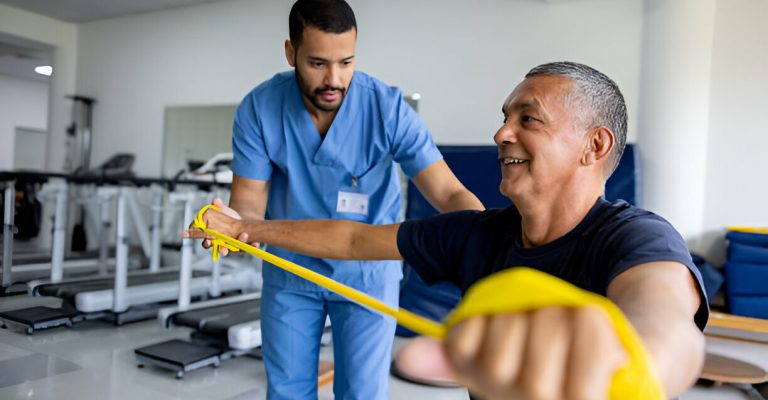Patients with spinal cord injury and occupational therapy professionals work hand in hand to achieve positive rehab results.
These professionals ensure that patients spend their time doing these activities to the fullest extent possible. They identify which typical tasks are of particular concern to the patients. They then find a way to upscale the patients’ involvement in those tasks.
Occupational therapy is similar to physical therapy in a way. This is because occupational therapy often uses very repetitive and specific exercises to regain mobility. The exercise is then repeated over and over. The repetition, in itself, is very important as it actually promotes neuroplasticity, the way the central nervous system will adapt and revert back to functioning again after an injury.
What is Spinal Cord Injury and Occupational Therapy?
Occupational therapy is more rounded than physical therapy. It involves using real-life tasks and practices to improve everyday life. For example, a person might learn how to get out of bed or brush their teeth all over again.
Not only that, occupational therapy uses two types of approaches: things that help to heal and things that help to cope. Finally, both make it easier for a person to do things independently after a spinal cord injury.
Another advantage is that it helps avoid problems or related issues that may occur after an injury. So, occupational therapy is beyond the main treatment—it is about leading a good life daily.
Therapeutic Occupational Activities for Patients with Spinal Cord Injury
Compensatory strategies usually use special tools to compensate for lost abilities. They are quite important for people with spinal cord injury and occupational therapy activities, SCI. These should involve joining physical therapy, PT, occupational therapy, and OT. However, these compensatory plans are important because they can be used daily.
Here are some compensatory compensatory ways. These are some strategies that can be taught in occupational therapy to people with a spinal cord injury:
Preparing the Vehicle Modifications for Driving
Even with a spinal cord injury, one can drive a car—how is that possible? Believe it or not, it can be accomplished through certain special car modifications like hand controls and seats that move around. All these alterations are safe and possible for you while driving.
But it is not as easy as just making these changes. First, you’ll need to take some written and practical tests, though. The tests are to ensure that you are able to drive without causing harm to others. All we want is everyone’s safety.
Who will assist in all of this? A special person named an occupational therapist. This therapist is not merely a therapist but also specially certified in driving rehabilitation. He or she will assist you in determining the kind of modifications your vehicle will require.
The icing on the cake is that they will train you to use these new modifications! So, with a little assistance and a few tweaks in your car, you’ll soon be on the road. Remember, always be safe!
Managing Urinary Incontinence with the Use of Catheters
One of the most common problems from a spinal injury is the inability to control the bladder muscles properly. Here’s a solution to help with that problem. It’s called catheterization, and the process is quite simple. It’s like a small tube that gets put inside the bladder to help drain the pee.
This will prevent leakages and may spare your kidneys from damage caused by urine staying in the bladder for a long time.
Now, for the best part, you can define how to use a catheter best. It could be kept in at all times or just used when needed. What is more, with a little learning from an occupational therapist kind of teacher.
Many people with spine injuries can even do these processes by themselves. This implies that they can go to the bathroom independently, which is a big boost to leading a normal life.
Utilizing a Leg-Lifter for Smoother Transitions
The leg-lifter device is very helpful to people whose backs are injured or whose spinal cords are affected. The device helps them move their feet and legs much more easily than if they were not using it. Therefore, it helps one get into a comfortable position with less struggle or need to move from one spot to another.
It is, in essence, easy to use the process. At first, one just needs to insert their foot in the loop available in the leg lifter. Then, just by pulling the strap, people with strong upper bodies, as he still was, could easily manage the motion of their legs and had no problem. And it even became easier and even simpler with a bit of practice.
Installing Grab Bars and Rails in Spinal Cord Injury
Holding on to something solid when you’re moving around is very important. Just think, like you were playing that game where you couldn’t walk, but with tags on your shoulders—and you used to fall over sometimes because of that!
Things could now get easier. Here’s a tip: put on some grab bars or rails. You are already aware of these from stairways, aren’t you? Place them in spots where there is quite a bit of movement. For example, near the bed, at the side of the toilet, or even around the bathtub. Such bars could be your best chum to avoid slipping and falling.
These grab bars come with suction cups. These could be quite awesome, and they are very available in many stores. But you have to be ultra-careful with those. You probably remember the childhood games and toys where you’d try to stick something with suction.
And it wouldn’t stick all the time. That’s what these bars will inevitably do. Mainly, this will happen if you expect them to hold you in really hot places, like a shower.
Putting on Clothes while on a Bed

For people who are unable to move parts of their body, it is more preferred to get dressed while in bed than while in a wheelchair. This gets a lot easier, considering the fact that the bed is wide and flat. It allows one to move freely on it without fearing it might tip over or fall. Once they have pulled on their clothes, they can easily make any needed adjustments to ensure they are comfortable once they sit up.
Adaptive Clothing for Independence and Comfort
Dressing is another critical part of everyday life that individuals with spinal cord injuries may struggle with. To a healthy person, this may appear as an extremely easy task. Still, it truly is not when mobility is limited. Adapted clothing then comes in handy.
Adaptive clothing is designed to be easily worn without or with limited involvement in dressing. The added features encompass Velcro for closure instead of buttons or zippers, elastic waistbands instead of regular ones, and oversized armholes to give the best possible reach. They are available in various styles and sizes to suit every person’s requirements and preferences.
Using a Handheld Showerhead While Sitting
The other danger area is if you have a spinal cord injury: when showering, you really need to be with a lot of care. It is a good idea to clean yourself seated to avoid slips or falls. Another wise move is using mats that do not slip on the floor and having a shower head that can be handheld, which aids in avoiding the cleaning process of body parts not meant to be cleaned.
What’s more, a sponge on a long handle may assist you in lower body cleaning, making it easier and safer for you to perform than when your balance and core are stronger.
It can be a drag to claw and scramble in and out of a bathtub sometimes. That’s why they make a type of bathroom assistive device called a “transfer bench.” This good guy right here makes the whole ordeal so much less difficult and safer when it has to be done in or out of the intake.
A transfer bench typically has four legs and a seat that straddles the bathtub’s edge. This allows for smooth movement from outside the tub to inside without lifting your legs up too high or risking slipping. Some versions even have a swivel seat for added convenience.

In a Nutshell
Spinal cord injury and occupational therapy will always go hand in hand. With these handy adaptations and tools, individuals with spinal cord injuries can regain independence and improve their quality of life. These solutions provide practical assistance and boost confidence and self-esteem, giving those affected by spinal cord injury a sense of empowerment as they navigate daily tasks.

